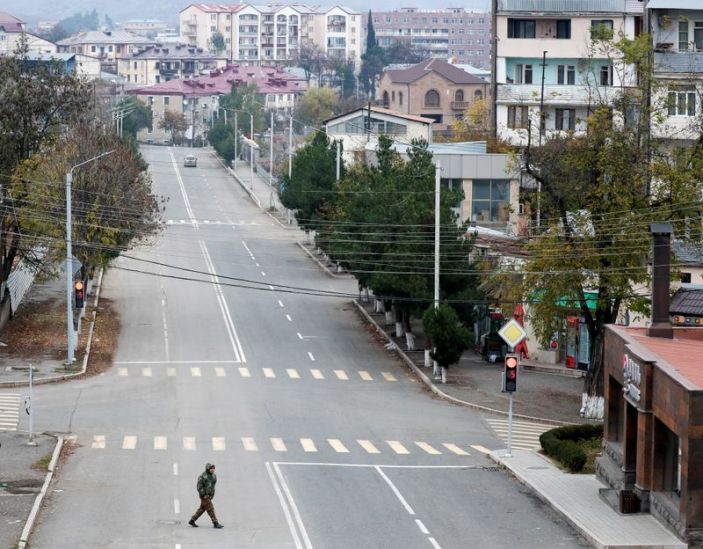to Nagorno-Karabakh to try to rebuild their shattered lives after Russia last week brokered a peace deal over the enclave.At least two convoys of buses carrying residents arrived in Stepanakert, the capital of the mountainous area, from neighbouring Armenia over the weekend.
Under the terms of the agreement, control over the enclave's main city Stepanakert, in territory internationally recognised as Azerbaijan, will stay with ethnic Armenians despite them being forced to cede other land to a victorious Azerbaijan.
On Monday, refugees lined up in the centre of Stepanakert, which had been deserted for weeks beforehand, to collect bags of humanitarian aid which included staples such as canned food and pasta.
Several men handed out rolled-up pieces of plastic which the returnees could use to fix broken windows in their homes
Some said they had come back with a heavy heart.
“I have seen the third war already here. In 1992 and 2016 I did not leave the city for even a minute. But this time it was awful,” said a middle-aged woman who declined to give her name.
The woman, who said she had returned on Sunday, said she had left for the Armenian border town of Sisian after the first week of fighting in early October when she had been forced to hide from shelling in a bomb shelter.
While Stepanakert may remain in ethnic Armenian hands after the deal, Shusha, the second largest town in Nagorno-Karabakh, is now controlled by Azerbaijan after fierce fighting.
“There are no Armenians in Shusha now,” said 35-year-old Alexander Simonyan, a gymnastics teacher from Shusha.
When the fighting began, he sent his wife and children to Armenia and joined the Nagorno-Karabakh defence forces.
He said he now lived with a friend in Stepanakert and had nowhere to house his family, though he hoped local authorities might offer them all somewhere to live. “This is our land. Where else can I go? I can’t live in another place.”
The Russian defence ministry said on Monday it had helped 475 people to return on Sunday and that a total of 725 people had come back to the enclave since Nov. 14.
LOST LAND
After the ceasefire, Andranik Sarkisyan, 27, a former fighter, managed to bring his wife and two sons back from Armenia to their home village of Badara in Nagorno-Karabakh.
News of the truce had been painful, he said. “I was on the front line and they (commanders) simply called and told us that the land has been given up. All the soldiers were crying.”
Sarkisyan worked as a hairdresser in Stepanakert before the war and went to fight in the district of Gadrut, which was taken by Azeri forces at the start of the conflict.
Many men in his battalion had been killed by artillery fire in an Oct. 11 attack, he said, adding that he had only survived because he had left earlier to guard a checkpoint.
“The guys were simply burnt, they died, we collected their body parts. I saw it every night. It was unbearable, impossible,” he said.
Such memories make it difficult for him to think about the terms of the settlement.
“It is not about land. It is about the blood spilled on it,” he said. “I hope it was the last war.”
































